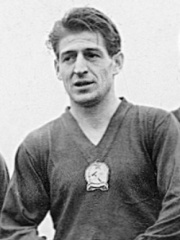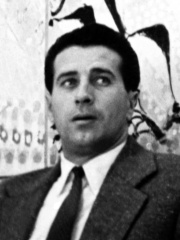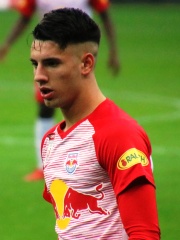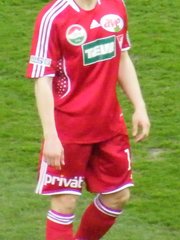







The Most Famous
SOCCER PLAYERS from Hungary
This page contains a list of the greatest Hungarian Soccer Players. The pantheon dataset contains 21,273 Soccer Players, 188 of which were born in Hungary. This makes Hungary the birth place of the 29th most number of Soccer Players behind Colombia, and Norway.
Top 10
The following people are considered by Pantheon to be the top 10 most legendary Hungarian Soccer Players of all time. This list of famous Hungarian Soccer Players is sorted by HPI (Historical Popularity Index), a metric that aggregates information on a biography's online popularity. Visit the rankings page to view the entire list of Hungarian Soccer Players.

1. Ferenc Puskás (1927 - 2006)
With an HPI of 82.61, Ferenc Puskás is the most famous Hungarian Soccer Player. His biography has been translated into 86 different languages on wikipedia.
Ferenc Puskás (né Purczeld; 1 April 1927 – 17 November 2006) was a Hungarian footballer and manager, widely regarded as one of the greatest players of all time and the sport's first international superstar. A forward and an attacking midfielder, he scored 84 goals in 85 international matches for Hungary and later played four international matches for Spain as well. He is the European all-time top assist provider in international football (53). He became an Olympic champion in 1952 and led his nation to the final of the 1954 World Cup. He won three European Cups (1959, 1960, 1966), ten national championships (five Hungarian and five Spanish Primera División) and eight top individual scoring honors. Known as the "Galloping Major", in 1995, he was recognized as the greatest top division scorer of the 20th century by the IFFHS. Scoring 802 goals in 792 official games during his career, he is the seventh top goal scorer of all time by the RSSSF. He was the son of former footballer Ferenc Puskás Senior. Puskás started his career in Hungary playing for Kispest and Budapest Honvéd. He was the top scorer in the Hungarian League on four occasions, and in 1948, he was the top goal scorer in Europe. During the 1950s, he was both a prominent member and captain of the Hungary national team, known as the Mighty Magyars. After the Hungarian Revolution, Puskás served a two year ban from UEFA. Despite failing to sign for Ethnikos Piraeus in 1957 under pressure from rival clubs, in 1958, he emigrated to Spain where he successfully signed for Real Madrid at the age of 31. While playing with the club, Puskás won four Pichichis and scored seven goals in two European Cup finals, winning the competition three times with the club and claiming five consecutive La Liga titles. He scored 619 goals in 618 matches in the Hungarian and Spanish leagues and National Cups. After retiring as a player, he became a coach. The highlight of his coaching career came in 1971 when he guided Panathinaikos to the European Cup final, where they lost 2–0 to Ajax. He also led the club to the championship in 1972, becoming an icon in the country. Afterward he'd have spells at various countries and clubs, including Spain, Paraguay and the Saudi Arabia national team, with varying success. He returned again to Greece to manage an exceptionally strong AEK team for the 1978–79 season. In 1993, he returned to Hungary and took temporary charge of the Hungary national team. In 1998, he became one of the first ever FIFA/SOS Charity ambassadors. In 2002, the Népstadion in Budapest was renamed the Puskás Ferenc Stadion in his honor. He was also declared the best Hungarian player of the last 50 years by the Hungarian Football Federation in the UEFA Jubilee Awards in November 2003. In October 2009, FIFA announced the introduction of the FIFA Puskás Award, awarded to the player who has scored the "most beautiful goal" over the past year. He was also listed in Pelé's FIFA 100.

2. Sándor Kocsis (1929 - 1979)
With an HPI of 73.82, Sándor Kocsis is the 2nd most famous Hungarian Soccer Player. His biography has been translated into 50 different languages.
Sándor Péter Kocsis (SHAWN-dor KOTCH-ish; Hungarian: [ˈʃaːndor ˈpeːtɛr ˈkot͡ʃiʃ]; 21 September 1929 – 22 July 1979) was a Hungarian footballer who played for Ferencvárosi TC, Budapest Honvéd, Young Fellows Zürich, FC Barcelona and Hungary as a striker. During the 1950s, along with Ferenc Puskás, Zoltán Czibor, József Bozsik and Nándor Hidegkuti, he was a member of the Mighty Magyars. After the 1956 Hungarian Revolution, he moved to Spain where he became a member of the FC Barcelona team of the late 1950s. Kocsis was a prolific goalscorer for both Budapest Honvéd and Hungary. While playing for Honvéd, he was the top goalscorer in any European league in both 1952 and 1954. He also scored 75 goals in 68 appearances for Hungary – a 1.10 goal/game average at the game's highest level. Kocsis was the top goalscorer in the 1954 World Cup with 11 goals, a record at the time for goals in a single World Cup. That year he scored 23 goals with his national team, the most by any player during a calendar year. He was also the first player to score two hat-tricks in a World Cup. His 2.2 goal/game average in the World Cup finals is second only to that of Ernst Wilimowski (Poland) who scored four goals in his only World Cup match, and only Just Fontaine has scored more goals than Kocsis in a single World Cup. According to the Rec.Sport.Soccer Statistics Foundation (RSSSF) he totalled 556 goals in 537 official games among which 123 goals in national team matches at all levels ranked third in recorded history. Kocsis was particularly known for scoring headers. His 1.103 goals/game average is ranked No.1 for players past 43 caps in FIFA class-A competition, closely followed by Gerd Müller with 1.097 goals/game (68 goals in 62 games). They are the only two players in history above a +1.0 goals/game average encompassing over 43 internationals. Ferenc Puskás with .99 goals/game (84 goals in 85 matches) is currently ranked 3rd. Sándor Kocsis registered a national record of seven hat tricks for Hungary, including a four-goal haul against West Germany at the 1954 World Cup.

3. László Kubala (1927 - 2002)
With an HPI of 73.52, László Kubala is the 3rd most famous Hungarian Soccer Player. His biography has been translated into 41 different languages.
László Kubala (10 June 1927 – 17 May 2002) was a professional footballer. He played as a forward for Ferencváros, Slovan Bratislava, Barcelona, and Espanyol, among other clubs. Regarded as one of the greatest players in history, Kubala is considered a hero of Barcelona. He was born in Hungary but also had Czechoslovak and Spanish citizenship, and played for the national teams of all three countries. Kubala was noted for his quick and skilful dribbling, composed and powerful finishing, and accuracy from free kicks. During the 1950s, he was a leading member of the successful Barcelona team, scoring 280 goals in 345 appearances (including unofficial goals). During the club's 1999 centenary celebrations, a fan's poll declared Kubala the best player ever to play for the Spanish club. After retiring as a player, he had two spells as coach of Barcelona and also coached both Spain's senior national team and Spain national under-21 football team.

4. Flórián Albert (1941 - 2011)
With an HPI of 72.30, Flórián Albert is the 4th most famous Hungarian Soccer Player. His biography has been translated into 50 different languages.
Flórián György Albert (15 September 1941 – 31 October 2011) was a Hungarian professional football player, manager and sports official, who was named European Footballer of the Year in 1967. Nicknamed "The Emperor", he played as a forward, and has been described as one of the most elegant footballers of all time. A club legend of Ferencvárosi TC, Albert joined the team as a schoolboy and spent his whole playing career at Fradi. He also starred for Hungary, winning 75 international caps and scoring 31 goals. He was joint top-scorer at the 1962 World Cup with four goals and played a key role in Hungary's third-place finish at the European Championship in 1964. He stayed loyal to Ferencváros after his retirement as well, actively participated in the club's life and also held administrative positions. From 2007 the stadium of Ferencváros bore his name, until 2014 when the new stadium of the team was constructed, named “Groupama Arena”. Albert died in October 2011, aged 70, in a hospital in Budapest after complications following heart surgery carried out a few days earlier.

5. Béla Guttmann (1899 - 1981)
With an HPI of 72.09, Béla Guttmann is the 5th most famous Hungarian Soccer Player. His biography has been translated into 35 different languages.
Béla Guttmann (Hungarian: [ˈbeːlɒ ˈɡutmɒnn]; 27 January 1899 – 28 August 1981) was a Hungarian footballer and coach. He was born in Budapest, Austria-Hungary, and was Jewish. He was deported by the Nazis to a Nazi slave labor camp where he was tortured; he survived the Holocaust. Before the war, he played as a midfielder for MTK Hungária, Hakoah Vienna, and several clubs in the United States. Guttmann also played for the Hungary national team, including at the 1924 Olympic Games. Guttmann coached in ten countries from 1933 to 1974, and won ten national championships and two consecutive European Cups with Benfica. He also coached the national teams of Hungary and Austria, having also coached club football in the Netherlands, Italy, Brazil, Uruguay, and Portugal. He is perhaps best remembered as a coach and manager after the war of AC Milan, São Paulo, Porto, Benfica and Peñarol. His greatest success came with Benfica when he guided them to two successive European Cup wins, in 1961 and in 1962. Guttmann pioneered the 4–2–4 formation along with Márton Bukovi and Gusztáv Sebes, forming a triumvirate of radical Hungarian coaches, and is also credited with mentoring young Eusébio at Benfica. Throughout his career, he was never far from controversy. Widely travelled, as both a player and coach, he rarely stayed at a club longer than two seasons, and was quoted as saying "the third season is fatal". He was sacked by Milan while they were top of Serie A, and he walked out on Benfica after they reportedly refused a request for a pay rise, leaving the club with a "curse".

6. Nándor Hidegkuti (1922 - 2002)
With an HPI of 70.52, Nándor Hidegkuti is the 6th most famous Hungarian Soccer Player. His biography has been translated into 40 different languages.
Nándor Hidegkuti (3 March 1922 – 14 February 2002) was a Hungarian football player and manager. He played as a forward or attacking midfielder and spent the majority of his playing career at MTK Hungária FC. During the 1950s he was also a key member of the Hungary national team known as the Golden Team. Other members of the team included Ferenc Puskás, Zoltán Czibor, Sándor Kocsis and József Bozsik. In 1953, playing as a deep-lying centre-forward, a position which has retroactively been compared to the modern false 9 role, he scored a hat-trick for Hungary when they beat England 6–3 at Wembley Stadium. Playing from deep, Hidegkuti was able to distribute the ball to the other attackers and cause considerable confusion to defences. This was an innovation at the time and revolutionised the way the game was played. Hidegkuti died on 14 February 2002 after suffering from heart and lung problems for some time. MTK Hungária FC renamed their stadium, Hidegkuti Nándor Stadium, in his honour.

7. Zoltán Czibor (1929 - 1997)
With an HPI of 69.24, Zoltán Czibor is the 7th most famous Hungarian Soccer Player. His biography has been translated into 38 different languages.
Zoltán Czibor (23 August 1929 – 1 September 1997) was a Hungarian footballer who played for several Hungarian clubs, including Ferencváros and Budapest Honvéd, and the Hungary national team before joining CF Barcelona. Czibor played as a left-winger or striker and was notable for having a powerful shot, good pace and excellent ball control. During the 1950s he was part of the Magical Magyars, reaching the World Cup final with them in 1954. After the 1956 Hungarian Revolution he moved to Spain where he became a prominent member of the successful FC Barcelona team of the late 1950s. After three seasons at Barcelona, he joined their local rivals Español for the 1961–62 season. After brief spells at FC Basel, Austria Wien and Primo Hamilton FC, he retired as a professional footballer and returned to Hungary. He died there in 1997, aged 68.

8. József Bozsik (1925 - 1978)
With an HPI of 68.28, József Bozsik is the 8th most famous Hungarian Soccer Player. His biography has been translated into 39 different languages.
József Bozsik (Hungarian pronunciation: [ˈjoːʒɛf ˈboʒik]; 28 November 1925 – 31 May 1978) was a Hungarian footballer who played as a central midfielder. He spent his entire club career at his hometown club, Budapest Honvéd. Bozsik was a key member of the legendary Golden Team as he represented Hungary in various international tournaments. Honvéd named their stadium, Bozsik József Stadion, after him.

9. Gyula Grosics (1926 - 2014)
With an HPI of 67.58, Gyula Grosics is the 9th most famous Hungarian Soccer Player. His biography has been translated into 36 different languages.
Gyula Grosics (Hungarian pronunciation: [ˈɟulɒ ˈɡroʃit͡ʃ]; 4 February 1926 – 13 June 2014) was a Hungarian football goalkeeper who played 86 times for the Hungary national football team and was part of the "Golden Team" of the 1950s. Regarded as one of the greatest goalkeepers of all time, he was thought to be the first goalkeeper to play as the sweeper-keeper. Grosics was nicknamed "Black Panther" (Hungarian: Fekete Párduc), because he wore black clothing while playing. He won a gold medal in football at the 1952 Summer Olympics.

10. György Sárosi (1912 - 1993)
With an HPI of 66.23, György Sárosi is the 10th most famous Hungarian Soccer Player. His biography has been translated into 31 different languages.
György Sárosi (Hungarian: [ˈʃaːroʃi ˈɟørɟ]; 5 August 1912 – 20 June 1993) was a Hungarian footballer. Sárosi was a complete footballer renowned for his versatility and technique among other things, and he played in several positions for Ferencváros and the Hungary national team. Essentially a second striker, he could also operate in midfield or central defence, and he helped Ferencváros win five Hungarian league titles between 1932 and 1941. He is considered one of the greatest players of the pre-war era. He scored a goal in the 1934 FIFA World Cup, but his finest hour came when he captained Hungary to the 1938 FIFA World Cup finals, where he scored five goals in the tournament, including one in the final to reduce Italy's lead to 3–2, although a Silvio Piola goal eventually finished off the Hungarians. He finished with the bronze ball for being the third-highest goalscorer of the tournament. He was named the 60th European Player of the Century in the IFFHS Century Elections. He is also fifth in the all-time top-goalscorers list for the Hungary national team, with 42 goals from 62 appearances. After his retirement he moved to Italy, where he managed a number of clubs, including Genoa, Juventus, Bari and Roma. He was also manager of Lugano. He died in 1993 aged 80.
People
Pantheon has 188 people classified as Hungarian soccer players born between 1886 and 2002. Of these 188, 87 (46.28%) of them are still alive today. The most famous living Hungarian soccer players include Antal Dunai, László Fazekas, and Tibor Nyilasi. The most famous deceased Hungarian soccer players include Ferenc Puskás, Sándor Kocsis, and László Kubala. As of April 2024, 20 new Hungarian soccer players have been added to Pantheon including Zsolt Lőw, Péter Disztl, and Sándor Sallai.
Living Hungarian Soccer Players
Go to all RankingsAntal Dunai
1943 - Present
HPI: 60.26
László Fazekas
1947 - Present
HPI: 60.11
Tibor Nyilasi
1955 - Present
HPI: 58.08
Gábor Király
1976 - Present
HPI: 57.96
Antal Nagy
1944 - Present
HPI: 57.87
László Kiss
1956 - Present
HPI: 56.09
László Bálint
1948 - Present
HPI: 55.93
Antal Szentmihályi
1939 - Present
HPI: 54.86
Lajos Kű
1948 - Present
HPI: 54.85
Gyula Rákosi
1938 - Present
HPI: 54.35
Dominik Szoboszlai
2000 - Present
HPI: 53.39
József Gelei
1938 - Present
HPI: 53.39
Deceased Hungarian Soccer Players
Go to all RankingsFerenc Puskás
1927 - 2006
HPI: 82.61
Sándor Kocsis
1929 - 1979
HPI: 73.82
László Kubala
1927 - 2002
HPI: 73.52
Flórián Albert
1941 - 2011
HPI: 72.30
Béla Guttmann
1899 - 1981
HPI: 72.09
Nándor Hidegkuti
1922 - 2002
HPI: 70.52
Zoltán Czibor
1929 - 1997
HPI: 69.24
József Bozsik
1925 - 1978
HPI: 68.28
Gyula Grosics
1926 - 2014
HPI: 67.58
György Sárosi
1912 - 1993
HPI: 66.23
Gusztáv Sebes
1906 - 1986
HPI: 66.11
Lajos Tichy
1935 - 1999
HPI: 65.83
Newly Added Hungarian Soccer Players (2025)
Go to all RankingsZsolt Lőw
1979 - Present
HPI: 47.92
Péter Disztl
1960 - Present
HPI: 47.69
Sándor Sallai
1960 - Present
HPI: 46.63
György Bognár
1961 - Present
HPI: 46.27
József Kardos
1960 - 2022
HPI: 45.67
Miklós Lendvai
1975 - 2023
HPI: 42.09
Péter Lipcsei
1972 - Present
HPI: 42.00
Imre Szabics
1981 - Present
HPI: 41.96
Martin Ádám
1994 - Present
HPI: 39.83
Gergely Rudolf
1985 - Present
HPI: 39.81
Tibor Dombi
1973 - Present
HPI: 39.22
Zsolt Nagy
1993 - Present
HPI: 39.01
Overlapping Lives
Which Soccer Players were alive at the same time? This visualization shows the lifespans of the 25 most globally memorable Soccer Players since 1700.



























